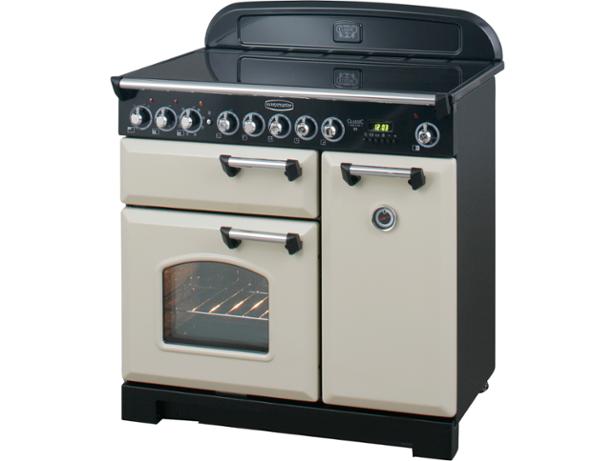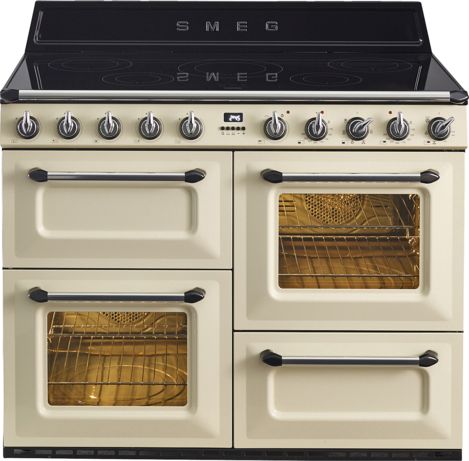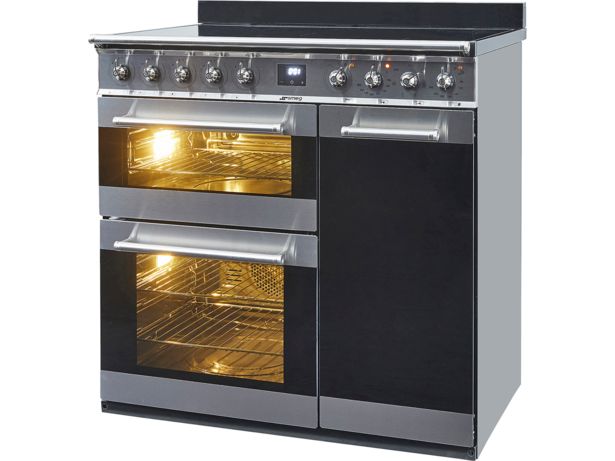By clicking a retailer link you consent to third party cookies that track your onward journey. If you make a purchase, Which? will receive an affiliate commission which supports our mission to be the UK's consumer champion.
Should you buy an Aga?

Aga cookers have become a fixture of many a kitchen since they launched in 1922. It’s not just the design that has endured – models dating back as far as the 1930s are still in use.
Today, a new two-oven Aga will set you back at least £7,650. But in return for this sizable investment, you’ll get a versatile, spacious cast-iron cooker that can provide warmth in the kitchen if you want it, or be switched off when you don’t.
If an Aga isn’t right for your home or budget, see our guide to the Best range cookers instead.
What is an Aga?
An Aga is a spacious cast-iron, radiant heat cooker with multiple ovens and cooking options. Built to order at the firm’s factory in Shropshire, all Agas come with a roasting oven, a simmering oven and one or two hotplates. There are also models with three or five ovens, as well as the option of an induction hob in addition to hotplates.
Traditional Aga models were designed to stay on all the time, so they didn’t have any dials or switches. Now, most Aga cookers can be switched off and on as needed, and ovens and hotplates can be operated independently. For colder, draughtier homes, the R Series AGA cookers are designed to be left on most of the time but have an 'e' setting or slumber mode, so they use less energy than older, more traditional models.
The radiant heat it produces is what gives the Aga its unique cooking ability. The cast-iron body stores heat efficiently, then transmits it throughout the various cooking zones.
Temperatures inside the ovens vary, but as a rough guide you can expect approximately 220-240°C in the roasting oven, 160-180°C in the baking oven and 100-120°C in the simmering oven. A thermostatic control maintains consistent temperatures.
The vast majority of new Aga cookers run on electricity, with some models offering dual-fuel combinations (such as electric ovens with gas hobs).
Aga pros and cons
Aga cookers have been a staple in many kitchens for decades, offering unique features and advantages over conventional range cookers. However, they do have drawbacks that potential buyers should consider.
Pros
- Heat storage An Aga uses a heat storage system, which means you can leave it on so it’s always ready to use.
- Even cooking Aga says the oven’s radiant heat locks in flavour and moisture – in contrast to the drying heat of a conventional oven – and distributes heat evenly for consistent results.
- Durability and longevity Aga cookers are made from cast iron, so they’re known for their durability and reliability and can last decades when properly maintained.
- Multi-functional and versatile An Aga has multiple ovens and hotplates, allowing simultaneous cooking of various dishes and potentially eliminating the need for other kitchen appliances. The ovens are also generally larger than those you'd find in conventional range cookers.
- Iconic design and wide range of sizes Aga cookers come in various designs and sizes, from 60cm to 210cm, to fit any kitchen style or space.
- Room warming options An Aga can provide constant heat to warm up your kitchen.
Cons
- High initial cost and running costs An Aga tends to be more expensive than a conventional range cooker – and its heat storage system consumes more energy, leading to higher utility bills.
- Limited temperature control Agas have fewer temperature control options compared to conventional range cookers, which could be a drawback for some users.
- An overly warm kitchen or longer heat-up times If the Aga is left on, it will heat up your kitchen, which may not be ideal in the summer. If the cooker is off, it takes a long time to heat up again compared to conventional cookers.
- Heavy, bulky, and less variety in styles Aga cookers are large and heavy, which can make installation more challenging and limit your options for kitchen layout, while offering fewer styles compared to conventional range cookers.
- Learning curve There is a learning curve associated with using Aga cookers, as they operate differently from conventional cookers.
If you're considering purchasing an Aga, it's important to weigh up the pros and cons based on your specific cooking needs, budget and kitchen space. The running costs can be reduced by opting for an electric Aga with programmable features that allow you to control when it's on and off.
How much does an Aga cost?
Aga 60: from £7,650
At just 60cm wide (the same size as a regular freestanding cooker), this model is ideal if you have a small kitchen. It comes with two ovens, which can be switched on and off independently of each other. One can be set to roasting or baking, while the other is set for simmering.
Most people choose a model with a hotplate, which can be set to boiling or simmering, or you can specify a four-burner gas hob. The top oven in an Aga 60 can be pre-programmed to come on when you need it.
Aga eR3 Series: from £10,490

The Aga eR3 Series provides a pair of cast-iron ovens, with one suitable for roasting or baking and the other for simmering purposes. These models can be kept on to maintain a cozy Aga warmth in your kitchen or turned off when it's not desired. The sizes of these models vary, ranging from 90cm to 170cm.
The Aga eR3 Series stoves also feature a separately heated warming oven. The 90cm and 150cm variants come with a taller version that includes a plate rack. For the 150cm, 160cm, and 170cm models, there's a 90-liter conventional fan oven available for times when the cast-iron ovens aren't in use or additional cooking space is required.
Each eR3 Series cooker is equipped with a two or three zone induction cooktop that includes a bridging function for use with griddles or fish kettles.
Aga R3 Series: from £11,050

These models cater to those who appreciated the always-on classic Aga but desire extra features and reduced running costs. The 13-amp electric Aga cookers in this range have independent oven and hotplate operations. Additionally, they come with a high-speed infrared grill. Each model has at least one hotplate (some have two), and all but one model include an induction hob.
Ideal for drafty kitchens, remote work settings, or simply enjoying the snug Aga ambiance, these models are available in sizes ranging from 90cm to 170cm.
The R3 Series also features an e-setting for times when you don't need the cooker but don't want to turn it off. This economy mode lowers the oven temperatures, reducing energy consumption and cutting down on operating costs. It takes about an hour to restore the R3 Series to full temperature from the e-setting.
For maximum cooking versatility, the Aga R3 Series 150cm, 160cm, and 170cm models come with an extra 90-litre conventional fan oven.
Aga Dual Control: from £14,275

Available in three or five-oven models, the Aga Dual Control offers more flexibility than the older models. It's only available as a dual-fuel cooker, and its hotplates can be controlled individually or turned off completely, which can help to reduce running costs.
Aga R7 Series: from £15,480

These models are tailored for those who desire a continuous heat source in their kitchen. The Aga R7 Series boasts three cast-iron ovens and a pair of independently controlled hotplates for boiling and simmering tasks.
The 100cm Aga R7 model comes with ovens for baking, roasting, and simmering. The 150cm variants include two extra ovens for slow cooking and warming, along with the option of a warming plate or a single-zone induction hob. The 160cm and 210cm models feature an additional slow cooking oven with an integrated grill, a fan oven, and a choice between a gas or ceramic hob.
With a user-friendly control panel, these ovens provide four temperature settings, including a slumber mode that maintains all ovens at lower temperatures to minimise energy usage.
Aga eR7 Series cookers: from £17,735

The Aga eR7 Series stoves come with a cast-iron baking oven, roasting oven, and simmering oven. The 150cm variant includes two extra ovens for slow cooking and warming, while the 160cm and 210cm models feature a slow cooking oven with a grill, a fan oven, and a choice between a gas or ceramic hob.
These electric cookers have two Aga hotplates for boiling and simmering, designed to fit extra-large pans or function as a cooking surface. The five-oven model offers a choice of a warming plate or a single-zone induction hob.
Controlled by an advanced digital touchscreen panel, the Aga eR7 roasting, baking, and simmering ovens, as well as the hotplates, can be switched on and off as needed and have adjustable oven temperatures. The roasting oven offers five settings, and the baking oven has four.
The ovens can be programmed to turn on automatically at specified days and times, ensuring they're ready to cook whenever needed.
Optional extras to consider
There are a few optional extras, including enamelled hotplate lids and a bespoke colour service. Adding these can bump up the price quite a bit.
Can you buy a second-hand Aga?

Yes. Given the longevity of Aga cookers and the cost, there is an active second-hand market.
By shopping around, it is possible to get a second-hand Aga that’s been renovated to look like new but comes at a much cheaper price. If you do go down this route, you will have to factor in dismantling, reconstruction, delivery and installation costs before working out how much of a bargain you’re getting.
Other costs to consider depend on what fuel type you’re after or if you want to have a boiler connected up to your Aga. If that’s the case, then new piping and fitting a flue are just a couple of things you’ll need to keep in mind.
Aganomics: how much does it cost to run an Aga?

The running costs for an Aga cooker are complex and much debated, so much so, it has developed an economic subdiscipline it calls Aganomics. There are so many varied models available; and once you factor in potential savings – such as the claim that an Aga’s multifunctionality eliminates the need for toasters, microwaves, radiators and some other appliances – you enter a minefield of sums and costs.
Ultimately, figuring out how much an Aga costs to run depends on which model you have, what fuel source you are using, and to what extent you will make use of any potential programming capabilities.
The majority of Aga cookers sold now run on electricity and have ovens and hotplates that can be controlled independently, and switched on and off as you need them. For example, on a freezing winter weekend, when you’re doing a lot of cooking, you might want to keep all the ovens on for the day; on a summer’s day, you might want to just switch on a hotplate for half an hour to griddle a piece of fish.
Running costs depend on the cooker you have and how you use it. The Aga eR Series is designed to be switched on and off, so costs are reflected in usage. The R models are generally on most of the time, but are designed to be in the e-setting when you’re not cooking or don’t need heat into the room, such as overnight, when you’re out or away, and during warmer months.
Below we give some estimated running costs for three-oven models across the range. Costs are based on Aga’s own energy-usage claims, which you can read out in more detail on the Aga website.
- Three-oven electric R3 Series: £19.95 per week with baking and simmering ovens running continuously on its e-setting.
- Three-oven electric eR3 Series: £22.14 per week with both cast-iron ovens on full temperature continuously.
- Three-oven electric R7: £38.35 per week with three ovens running continuously in economy mode.
These calculations are all based on an electricity cost of 27p per kWh.
Servicing should also be factored in: oil-fuelled Agas need to be serviced every six months and gas-fuelled ones every year. Electric models don’t need to be serviced, but to keep Aga’s five-year warranty valid, they should also be checked every 12 months.
Conventional range cookers from Aga
If you like the workmanship and design of an Aga but want the flexibility of a conventional range cooker, it’s worth taking a look at the Aga Masterchef Deluxe, which offers a blend of advanced cooking features. It’s available in two sizes – 90cm and 110cm – with either a five-zone induction hob or five-burner gas hob. The 110cm cooker has a fan oven, a slow cooking oven, and a large 79-litre capacity multifunction oven with eight cooking functions. Aga Masterchef Deluxe models start at around £4,955.
The Mercury cooker has two separate ovens, including a large multi-function oven, a fan oven and a glide-out grill offering full and half grilling functions. You can also choose between either a five-zone induction hob or gas hob. The Mercury is available in seven finishes and three sizes: 100cm, 110cm and 120cm. Aga Mercury models start at around £5,250.
Keep an eye on our range cooker reviews to see how Aga range cookers match up against models from Belling, Stoves and Rangemaster.
What is a Rayburn?

A Rayburn is a range cooker. Some Rayburns come with a built-in boiler that can provide hot water and, with certain models, heat up multiple radiators around the house. They're made from cast iron with an enamel finish, and look like Aga range cookers – they’re actually made by Aga at the same factory in Shropshire. They have a lidded hotplate top and come with two ovens – one for cooking and one for warming (models with two cooking ovens are also available).
Aside from their ability to provide central heating and hot water, Rayburns differ from Aga models in that they are available to run on oil or gas for the heating and hot water models. There are also Rayburns that are HVO compatible. HVO is 95% hydrotreated vegetable oil.
The Rayburn Ranger is a recently launched contemporary all-electric, cooker-only model.
There are a wide range of Rayburn models, each offering varied heating and cooking capabilities, plus compatibility with different fuel types. Prices start from around £9,215 for cookers in the Rayburn 300 series and go up to £13,330 for models in the 600 Series that are capable of heating larger houses.
How to choose between an Aga and a Rayburn
If cooking is your key concern, then you’ll want to go for an Aga as they provide a more cooking versatility with the option of two to five-oven models and the option to have a conventional oven and induction hob too. If you have an existing heating system that you’re happy with and a fairly modern boiler, then an Aga is probably right for you.
If you need a lot of hot water and wish to use oil, gas or HVO, then choose a Rayburn. It's also probably better to go for a Rayburn if you need to run your central heating and cook from one system.


